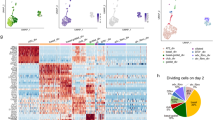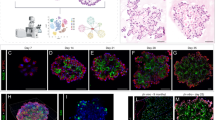Abstract
Successful recovery from lung injury requires the repair and regeneration of alveolar epithelial cells to restore the integrity of gas-exchanging regions within the lung and preserve organ function. Improper regeneration of the alveolar epithelium is often associated with severe pulmonary fibrosis, the latter of which involves the recruitment and activation of fibroblasts, as well as matrix accumulation. Type 2 alveolar epithelial cells (AEC2s) are stem cells in the adult lung that contribute to the lung repair process. The mechanisms that regulate AEC2 renewal are incompletely understood. We provide evidence that expression of the innate immune receptor Toll-like receptor 4 (TLR4) and the extracellular matrix glycosaminoglycan hyaluronan (HA) on AEC2s are important for AEC2 renewal, repair of lung injury and limiting the extent of fibrosis. Either deletion of TLR4 or HA synthase 2 in surfactant-protein-C-positive AEC2s leads to impaired renewal capacity, severe fibrosis and mortality. Furthermore, AEC2s from patients with severe pulmonary fibrosis have reduced cell surface HA and impaired renewal capacity, suggesting that HA and TLR4 are key contributors to lung stem cell renewal and that severe pulmonary fibrosis is the result of distal epithelial stem cell failure.
This is a preview of subscription content, access via your institution
Access options
Subscribe to this journal
Receive 12 print issues and online access
$209.00 per year
only $17.42 per issue
Buy this article
- Purchase on Springer Link
- Instant access to full article PDF
Prices may be subject to local taxes which are calculated during checkout






Similar content being viewed by others
Accession codes
Primary accessions
Gene Expression Omnibus
Referenced accessions
NCBI Reference Sequence
References
Rakoff-Nahoum, S., Hao, L. & Medzhitov, R. Role of toll-like receptors in spontaneous commensal-dependent colitis. Immunity 25, 319–329 (2006).
Rakoff-Nahoum, S., Paglino, J., Eslami-Varzaneh, F., Edberg, S. & Medzhitov, R. Recognition of commensal microflora by toll-like receptors is required for intestinal homeostasis. Cell 118, 229–241 (2004).
Fukata, M. et al. Cox-2 is regulated by Toll-like receptor 4 (TLR4) signaling: role in proliferation and apoptosis in the intestine. Gastroenterology 131, 862–877 (2006).
Hogan, B.L. et al. Repair and regeneration of the respiratory system: complexity, plasticity and mechanisms of lung stem cell function. Cell Stem Cell 15, 123–138 (2014).
Kotton, D.N. & Morrisey, E.E. Lung regeneration: mechanisms, applications and emerging stem cell populations. Nat. Med. 20, 822–832 (2014).
Desai, T.J., Brownfield, D.G. & Krasnow, M.A. Alveolar progenitor and stem cells in lung development, renewal and cancer. Nature 507, 190–194 (2014).
Barkauskas, C.E. et al. Type 2 alveolar cells are stem cells in adult lung. J. Clin. Invest. 123, 3025–3036 (2013).
Hofer, C.C., Woods, P.S. & Davis, I.C. Infection of mice with influenza A/WSN/33 (H1N1) virus alters alveolar type II cell phenotype. Am. J. Physiol. Lung Cell. Mol. Physiol. 308, L628–L638 (2015).
Liu, Y., Kumar, V.S., Zhang, W., Rehman, J. & Malik, A.B. Activation of type II cells into regenerative stem-cell-antigen-1+ cells during alveolar repair. Am. J. Respir. Cell Mol. Biol. 53, 113–124 (2015).
Rock, J.R. et al. Multiple stromal populations contribute to pulmonary fibrosis without evidence for epithelial-to-mesenchymal transition. Proc. Natl. Acad. Sci. USA 108, E1475–E1483 (2011).
Jiang, D. et al. Regulation of lung injury and repair by Toll-like receptors and hyaluronan. Nat. Med. 11, 1173–1179 (2005).
Jiang, D., Liang, J., Li, Y. & Noble, P.W. The role of Toll-like receptors in non-infectious lung injury. Cell Res. 16, 693–701 (2006).
Jiang, D., Liang, J. & Noble, P.W. Hyaluronan in tissue injury and repair. Annu. Rev. Cell Dev. Biol. 23, 435–461 (2007).
Noble, P.W. & Jiang, D. Matrix regulation of lung injury, inflammation and repair: the role of innate immunity. Proc. Am. Thorac. Soc. 3, 401–404 (2006).
Jiang, D., Liang, J. & Noble, P.W. Hyaluronan as an immune regulator in human diseases. Physiol. Rev. 91, 221–264 (2011).
Camenisch, T.D. et al. Disruption of hyaluronan synthase 2 abrogates normal cardiac morphogenesis and hyaluronan-mediated transformation of epithelium to mesenchyme. J. Clin. Invest. 106, 349–360 (2000).
American Thoracic Society. Idiopathic pulmonary fibrosis: diagnosis and treatment. International consensus statement. The joint statement of American Thoracic Society (ATS) and the European Respiratory Society (ERS). Am. J. Respir. Crit. Care Med. 161, 646–664 (2000).
Selman, M. et al. Idiopathic pulmonary fibrosis: pathogenesis and therapeutic approaches. Drugs 64, 405–430 (2004).
Noble, P.W., Barkauskas, C.E. & Jiang, D. Pulmonary fibrosis: patterns and perpetrators. J. Clin. Invest. 122, 2756–2762 (2012).
Amin, R.S. et al. Surfactant protein deficiency in familial interstitial lung disease. J. Pediatr. 139, 85–92 (2001).
Thomas, A.Q. et al. Heterozygosity for a surfactant protein C gene mutation associated with usual interstitial pneumonitis and cellular nonspecific interstitial pneumonitis in one kindred. Am. J. Respir. Crit. Care Med. 165, 1322–1328 (2002).
Garcia, C.K. Idiopathic pulmonary fibrosis: update on genetic discoveries. Proc. Am. Thorac. Soc. 8, 158–162 (2011).
Alder, J.K. et al. Telomere dysfunction causes alveolar stem cell failure. Proc. Natl. Acad. Sci. USA 112, 5099–5104 (2015).
Chen, H. et al. Airway epithelial progenitors are region specific and show differential responses to bleomycin-induced lung injury. Stem Cells 30, 1948–1960 (2012).
Mummert, M.E., Mohamadzadeh, M., Mummert, D.I., Mizumoto, N. & Takashima, A. Development of a peptide inhibitor of hyaluronan-mediated leukocyte trafficking. J. Exp. Med. 192, 769–779 (2000).
Li, Y. et al. Severe lung fibrosis requires an invasive fibroblast phenotype regulated by hyaluronan and CD44. J. Exp. Med. 208, 1459–1471 (2011).
Matsumoto, K. et al. Conditional inactivation of Has2 reveals a crucial role for hyaluronan in skeletal growth, patterning, chondrocyte maturation and joint formation in the developing limb. Development 136, 2825–2835 (2009).
Eblaghie, M.C., Reedy, M., Oliver, T., Mishina, Y. & Hogan, B.L. Evidence that autocrine signaling through Bmpr1a regulates the proliferation, survival and morphogenetic behavior of distal lung epithelial cells. Dev. Biol. 291, 67–82 (2006).
Gonzalez, R.F., Allen, L., Gonzales, L., Ballard, P.L. & Dobbs, L.G. HTII-280, a biomarker specific to the apical plasma membrane of human lung alveolar type II cells. J. Histochem. Cytochem. 58, 891–901 (2010).
Armstrong, L. et al. Expression of functional toll-like receptor–2 and -4 on alveolar epithelial cells. Am. J. Respir. Cell Mol. Biol. 31, 241–245 (2004).
Abreu, M.T. et al. Decreased expression of Toll-like receptor 4 and MD-2 correlates with intestinal epithelial cell protection against dysregulated proinflammatory gene expression in response to bacterial lipopolysaccharide. J. Immunol. 167, 1609–1616 (2001).
Neal, M.D. et al. Toll-like receptor 4 is expressed on intestinal stem cells and regulates their proliferation and apoptosis via the p53-upregulated modulator of apoptosis. J. Biol. Chem. 287, 37296–37308 (2012).
Pivarcsi, A. et al. Expression and function of Toll-like receptors 2 and 4 in human keratinocytes. Int. Immunol. 15, 721–730 (2003).
Oh, K. et al. Epithelial transglutaminase 2 is needed for T cell interleukin-17 production and subsequent pulmonary inflammation and fibrosis in bleomycin-treated mice. J. Exp. Med. 208, 1707–1719 (2011).
Tadokoro, T. et al. IL-6–STAT3 promotes regeneration of airway ciliated cells from basal stem cells. Proc. Natl. Acad. Sci. USA 111, E3641–E3649 (2014).
Tebbutt, N.C. et al. Reciprocal regulation of gastrointestinal homeostasis by SHP2 and STAT-mediated trefoil gene activation in gp130-mutant mice. Nat. Med. 8, 1089–1097 (2002).
Zhang, S. et al. Interleukin 6 mediates the therapeutic effects of adipose-derived stromal–stem cells in lipopolysaccharide-induced acute lung injury. Stem Cells 32, 1616–1628 (2014).
Le, T.T. et al. Blockade of IL-6 trans-signaling attenuates pulmonary fibrosis. J. Immunol. 193, 3755–3768 (2014).
O'Donoghue, R.J. et al. Genetic partitioning of interleukin-6 signaling in mice dissociates Stat3 from Smad3-mediated lung fibrosis. EMBO Mol. Med. 4, 939–951 (2012).
Rafii, S. et al. Platelet-derived SDF-1 primes the pulmonary capillary vascular niche to drive lung alveolar regeneration. Nat. Cell Biol. 17, 123–136 (2015).
Cao, Z. et al. Targeting of the pulmonary capillary vascular niche promotes lung alveolar repair and ameliorates fibrosis. Nat. Med. 22, 154–162 (2016).
Guzy, R.D., Stoilov, I., Elton, T.J., Mecham, R.P. & Ornitz, D.M. Fibroblast growth factor 2 is required for epithelial recovery, but not for pulmonary fibrosis, in response to bleomycin. Am. J. Respir. Cell Mol. Biol. 52, 116–128 (2015).
Chapman, H.A. et al. Integrin α6β4 identifies an adult distal lung epithelial population with regenerative potential in mice. J. Clin. Invest. 121, 2855–2862 (2011).
Lee, J.H. et al. Lung stem cell differentiation in mice directed by endothelial cells via a BMP4–NFATc1–thrombospondin-1 axis. Cell 156, 440–455 (2014).
Treutlein, B. et al. Reconstructing lineage hierarchies of the distal lung epithelium using single-cell RNA-seq. Nature 509, 371–375 (2014).
Vaughan, A.E. et al. Lineage-negative progenitors mobilize to regenerate lung epithelium after major injury. Nature 517, 621–625 (2015).
Takeuchi, O. et al. Differential roles of TLR2 and TLR4 in recognition of Gram-negative and Gram-positive bacterial cell wall components. Immunity 11, 443–451 (1999).
Kawai, T., Adachi, O., Ogawa, T., Takeda, K. & Akira, S. Unresponsiveness of MyD88-deficient mice to endotoxin. Immunity 11, 115–122 (1999).
Jeannotte, L. et al. Unsuspected effects of a lung-specific Cre deleter mouse line. Genesis 49, 152–159 (2011).
Morales-Nebreda, L.I. et al. Lung-specific loss of α3-laminin worsens bleomycin-induced pulmonary fibrosis. Am. J. Respir. Cell Mol. Biol. 52, 503–512 (2015).
Dong, Y. et al. Blocking follistatin-like 1 attenuates bleomycin-induced pulmonary fibrosis in mice. J. Exp. Med. 212, 235–252 (2015).
Lovgren, A.K. et al. β-arrestin deficiency protects against pulmonary fibrosis in mice and prevents fibroblast invasion of extracellular matrix. Sci. Transl. Med. 3, 74ra23 (2011).
Jiang, D. et al. Regulation of pulmonary fibrosis by chemokine receptor CXCR3. J. Clin. Invest. 114, 291–299 (2004).
Liang, J. et al. A macrophage subpopulation recruited by CC chemokine ligand 2 clears apoptotic cells in non-infectious lung injury. Am. J. Physiol. Lung Cell. Mol. Physiol. 302, L933–L940 (2012).
Liang, J. et al. Role of hyaluronan and hyaluronan-binding proteins in human asthma. J. Allergy Clin. Immunol. 128, 403–411.e3 (2011).
Jiang, D. et al. Inhibition of pulmonary fibrosis in mice by CXCL10 requires glycosaminoglycan binding and syndecan 4. J. Clin. Invest. 120, 2049–2057 (2010).
Acknowledgements
We thank M. Leonado, Y. Jung and V. Hu for technical support. This work was supported by US National Institute of Health (NIH) grants P01 HL108793 (P.W.N.), R01 HL060539 (P.W.N.), AI052201 (P.W.N.) and R01 HL122068 (D.J.), and California Institute for Regenerative Medicine grant RB5-07302 (P.W.N.). We thank B.L.M. Hogan for critical reading of the manuscript and for providing invaluable comments. We are grateful to S. Akira (University of Osaka, Japan), Y. Yamaguchi (Sanford–Burnham Medical Research Institute) and L. Dobbs (University of California, San Francisco) for providing critical reagents for the study.
Author information
Authors and Affiliations
Contributions
All authors participated in the design, execution and interpretation of the study. P.W.N., D.J. and J.L. conceived and designed the study; J.L. performed the majority of experiments and analyzed data; Y.Z., T.X., N.L., H.C., Y.G., A.K., J.M.M. and D.J. performed experiments and analyzed data; B.R.S. contributed to the design and interpretation of the study, and provided critical reagents; J.L., D.J. and P.W.N. wrote the manuscript; and P.W.N. and D.J. approved the submission.
Corresponding authors
Ethics declarations
Competing interests
The authors declare no competing financial interests.
Supplementary information
Supplementary Text and Figures
Supplementary Figures 1–8 (PDF 3959 kb)
Rights and permissions
About this article
Cite this article
Liang, J., Zhang, Y., Xie, T. et al. Hyaluronan and TLR4 promote surfactant-protein-C-positive alveolar progenitor cell renewal and prevent severe pulmonary fibrosis in mice. Nat Med 22, 1285–1293 (2016). https://doi.org/10.1038/nm.4192
Received:
Accepted:
Published:
Issue Date:
DOI: https://doi.org/10.1038/nm.4192
This article is cited by
-
Bcl6 drives stem-like memory macrophages differentiation to foster tumor progression
Cellular and Molecular Life Sciences (2023)
-
Function of epithelial stem cell in the repair of alveolar injury
Stem Cell Research & Therapy (2022)
-
Human alveolar type 2 epithelium transdifferentiates into metaplastic KRT5+ basal cells
Nature Cell Biology (2022)
-
Radiation-induced toxicity in rectal epithelial stem cell contributes to acute radiation injury in rectum
Stem Cell Research & Therapy (2021)
-
Lung organoids, useful tools for investigating epithelial repair after lung injury
Stem Cell Research & Therapy (2021)



